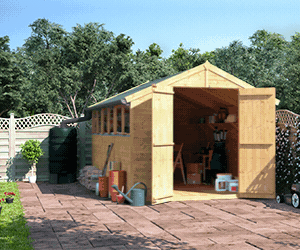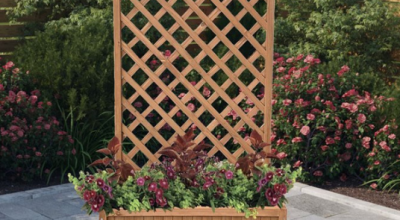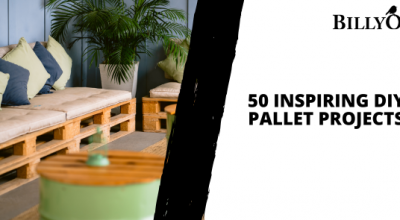Jump to:
Well-designed garden border ideas guarantee a thriving backyard landscape. It also offers an appealing look that can add curbside appeal to homes.
Moreover, it dresses up the landscape, highlights specific areas and adds texture. Garden borders can ensure your yard is in full bloom all year round!
To help you create the perfect planting scheme, here are some tips and inspirations.
1. Colour blocks
Why not try a garden border that showcases a nifty little design trick like using colour blocks. For this concept, repeat the colour in blocks to draw the eye along the entire border.
You can feature different plants with the same range of colours for each row. Or stick to a simpler design, such as this red Begonia and yellow Coleus garden border.
2. Brick edging
Bricks are great for creating a landscape edge for many reasons. Assemble them in a shallow trench to form a nice barrier between the garden bed and grass.
Top tip: A neat and clean border or edge provides uniformity to a landscape.

3. Variety of plants for contrast
Harmony is important, and so is diversity. Opt for plants with distinctive colours and dramatic shapes to create focal points. Spiky Palms and Pencil Junipers are an excellent choice.
4. Steel edging
Thinking of adding rustic charm to your landscape? Installing metal edging can give you that perfect look. Create a zigzag pattern or install corten steel panels in levels.
5. Edible crops
If you have a sunny garden, make the most of it with an edging of fresh and hearty herbs and veggies! Count on edibles like basil and curly leaf kale.
Fill the borders with annuals and perennials to add colour and texture.

6. Mixed borders
Mixed borders are best for urban and suburban gardens. Plant trees, shrubs, roses, perennials and bulbs together, for instance, for interest.

7. Water feature focal point
Include a focal point, such as a birdbath or small fountain, nestled next to taller planters. If your borders have curves, place a water feature in the part of the curve that juts forwards.

8. Focus on shapes
The shape of plants is just as important as their colour. For one, the shape helps to structure the planting. Meanwhile, the colour and texture supply the finishing touches.
Focusing on shapes helps add interest another layer to your garden border.
9. Line path borders with bulbs
Bulbs are perfect as borders as they give structure and seasonal interest to gardens. They can also grow through perennials, giving you more colour bursts.

10. Trees for height
Trees in borders, paired with tall and majestic plants, will add lovely tiered height to your garden. This method is perfect if you want your border to look informal.

11. Gabion walls
Gabion walls look natural and structured, blending well with the natural environment. They work as a retaining wall holding plants and soil.
This edging is an excellent option if you want a sturdy border that holds up well.

12. Stones on deck
A rock border adds polish to the design; at the same time, it makes a difference for decking. This is a unique way to differentiate your deck from where your garden starts. Check our garden decking ideas for more!
13. Shrubs for volume
Not only do shrubs offer year-round interest to gardens, but they also add volume to borders. Evergreens with good form and shapely leaves are ideal for small spaces.
Note: Consider size at maturity as some shrubs can grow to monstrous proportions.

14. Think vertical
In addition to shrubs and trees, climbers also add height. Hence, take full advantage of walls and fences, too! Mix non-invasive seasonal climbers to prolong the season of interest.

15. Fill the border with scented plants
Scented plants enliven any garden in an instant. Scents such as Dutch honeysuckle and white jasmine, perfume the air wonderfully. Imagine walking into your garden to these pleasing aromas!

16. Scrap-treated wood
The mini boards from scrap wood or pallets of this garden border are enough to define the bed. If you’re looking for a cheaper alternative, this can be an excellent option for you. Paint them to make them more aesthetically pleasing.
17. Garden hose
Breathe new life into your old garden hoses and take a cue from this one-of-a-kind border/fence. A unique and creative way to add garden edging ideas to your backyard, indeed!
18. Short to tall
Arrange your garden border with shorter plants in front and taller ones at the back. Fill three height slots: short, medium and tall. This applies to annuals, perennials or edible plants.

19. Statues
Other than birdbaths, statues also create a striking focal point. This is especially true when elevated above plantings. Have a look at this dreamy garden border filled with lush tulips and lavender, with a central statue.
20. Plastic cobblestones
Made of plastic material, these faux cobbled stones feature a bridge edge and design face. Make sure to allow extra room to plant flowers and shrubs during installation.
What’s more, the colour doesn’t take away from the beautiful colours of the plants, and it’s easy to install!
21. Glass bottles
Glass bottles catch the eye and make a great landscape border that keeps certain pests at bay. It’s especially fun to craft a bottle border if you have many uneven-sized bottles.

22. Terracotta pots
The terracotta pots laid out make for a fascinating, whimsical look. For a nice effect, design it in a tubular shape – just like the one in the photo below.
This is a great garden border/edging idea if you want something different from others.
23. River rocks
A river rock border brings a naturalistic feel to the garden. There are so many ways to incorporate them, and they can be used in all kinds of spaces. For added interest, show off different sizes and shapes.

24. Stones and bricks
Brick edging and a pebble path are stylish ideas and a great pair. They give off a touch of well-grooming and make a statement at the same time. Great for outlining patios, walkways, and other landscape elements.
25. Living edges
The simplest and most cost-effective way to edge a garden bed is with actual plants. A fresh idea for contemporary gardens that lets you skip beds and just frame the parts with plants. These can be any types of succulents, cacti, flowers and greenery that you like.
26. Light them up
A great way to light up your walkways and other parts of the garden at night! Outdoor lighting ideas like this give a modern feel to the space and a stylish accent. It also makes a good alternative to lamps and lanterns.

27. Coastal shells
You wouldn’t want any edging style than this one for your beach garden setting. Opt for huge shells to create a border as they are more visible and add interest to the theme. For smaller shells, you may use them on the borders instead of pebbles.
28. Cinder blocks
The thing we like about cinder blocks is that they can double as both edges and planters. They’re also inexpensive, and you can make them exposed or sunken to match your style. Cinder blocks are also perfect if you wish to create second or more layers of flowers.
29. Large metal pipes
Large metal pipes with succulents are a unique and creative way to border your garden. The rustic vibe they give double when they become rustier over time. Like cinder blocks, they can function like planters – with pebbles or soil in them.
30. Stacked flat stones
This shows a nice way to edge a flower bed or a tree using short, flat, tiled rocks stacked on top of each other. The idea is simple while offering a casual look. Also works well for separating the lawn edge from the mulch and flower bed.
31. To edge a patio deck
This design approach is brilliant if you want to differentiate the deck from the garden. It simply adds a “polish” to the look. Stone rocks, for one, make a great border choice for this.

32. Corrugated steel panels
Corrugated steels offer a neat look for landscape edging. Ideal for a minimalist garden setting, it simply looks clean and simple. The colours are not too busy, and you can use full-sized ones and install them vertically.
33. Crushed rock filling
This lawn edging idea provides a contrast with brick and a crushed rock filling between. The height of the stones offers a clear boundary without intruding on the landscape. Top tip: Pour any excess crushed rock over the existing crushed ones and rake it smooth.
34. Railroad tie
Railroad ties are combined with sand, concrete, or gravel to create modern landscaping designs. They have both a traditional and contemporary feel. The rustic look also adds an aesthetic design feature.
Note: Not recommended in vegetable gardens where contact is inevitable.
35. Laid tree stump
This edging concept has a lot of detail – and you might not notice the bottle walkway at first glance. But the highlight of this landscape is the laid tree stump that acts as the edging. Cut the tree trunks and lay them out to create borders.
36. Braided woven vines
This woven garden edging gives off a rustic feel and a touch of creativity. The braided vine edges will look brilliant if you have a cottage-themed garden! They also make great material for fences and trellises.
37. China plate edging
These dinner plates make a very unusual way to set up a garden border. But the old ones that would otherwise sit in a china cabinet can still have their purpose. Take a cue from this China plate edging that will suit your Chinese garden setting.
38. Repurposed hubcaps
It’s absolutely clever and unique using the hubcaps as garden bed edging. They’re practical, affordable and good-looking additions to the landscape. Perfect for an industrial-styled garden setting.
39. Repeat planting scheme
Repetition in garden borders is the easiest way to merge a planting scheme. This idea also helps mark out a ‘designed’ border. Use the same hedging throughout or repeat evergreen perennials.
Or put ornamental grasses in drifts at the front of beds and borders.
40. Graduated stone bed
Graduated stone bed edging provides excellent contrast. The small stones create a nice transition border, while the large ones make up the bed. A pleasing way to put in place a natural border.
41. Mini fence
Imitate your garden fence set up around the yard and make a miniature version for the borders. It’s easy to install, and it can transform the edges of your lawn or beds in a matter of minutes.
Opt for a fence which has been treated for year-round use.
42. Pebble moat
There are two approaches to building rock edging for a lawn or decking. One of them is to create a pebble moat.
Take this patio deck, for example. It rises out from the surrounding pebbles, which gives the impression of a pebble moat. The sleek lines also make the overall appearance contemporary and artistic.
43. Sharp edge lawn
The straight edges and angular corners of the lawn give off a simple yet give strong look. Ideal for both modern and minimalist gardens.
The style will also work on artificial turf paired with stone slabs to create this sleek vibe.
44. Contemporary block edging
Large blocks like these can serve dual purposes. They can provide a neat border while enclosing the soil or crushed rocks within to avoid overspill. The clean lines and simple style will also suit a contemporary front or back garden.
45. Landscape with boulders
Creating an edge with boulders is simply a case of sourcing large rocks. Then, pile them on top of each other along the perimeter of your garden. This design idea is especially great if you have boulders on your property.

46. Oriental grasses
Oriental grasses are environmentally friendly, and they don’t need staking, dead-heading or spraying. Fescues, for one, are considered low-growers and are often used as edgings and borders.
Grow them in a mixed border where their foliage and upright habit contrast with bright summer blooms.

47. Tetris-style wall border
Giving off a modern and rustic look, these rough stones are perfect for adding a Tetris style to your lawn edges. Stack the stones however you like to create a unique look. The design will surely make your garden stand out!
48. Grow a series of lavender
Loved for its beautiful blooms and delicate fragrance, lavender edging is worth considering. It can provide the perfect frame for your garden design – just like this one! Add a row of dazzling purple flowers to hide the rough edge of the lawn.
49. Cobblestones
Cobblestones transform simple garden landscaping into something that’s neat and organised. They provide a formal definition of beds, pathways and other garden areas. Great for front garden makeovers or backyard lawn edging.
50. With an in-built bench
The addition of a bench into the mix will serve a double purpose. It allows you to give your garden a rustic edge while also offering more seating space.
Use thick wooden planks or read our garden bench ideas for other design options. Remember, a well-placed bench in the yard can make a huge difference.
51. Rustic log edging
Use logs of varying lengths and diameters to create a charming border. Simply dig a shallow trench along the edge of your garden bed. Then, position the logs vertically in the trench, and secure them in place with stakes if needed.

52. Herb spiral
Construct a spiral-shaped raised bed with stones or bricks. This technique will create multiple levels for planting different herbs. This design maximises space and allows for optimal drainage. Place taller herbs at the centre and gradually plant shorter herbs as you move outward.
53. Bamboo fencing
Use bamboo panels or rolled bamboo fencing to create a natural border. Install sturdy support posts, attach the bamboo fencing, and secure it in place. Bamboo provides privacy, adds a touch of elegance, and is eco-friendly.

54. Salvaged metal edging
Use old metal pieces, such as corrugated roofing sheets or metal strips, as a unique garden border. Bury the metal pieces partially in the ground along the garden’s edge. This ensures they’re securely positioned, creating a clean separation.
55. Raised bed borders
Build raised beds using timber, stone, or brick materials. These elevated borders not only define the garden space but also improve drainage. Construct rectangular or square frames. Then fill them with soil, and plant your desired flowers, vegetables, or herbs.

(Image Credit: Wikimedia Commons)
56. Succulent border
Create a stunning border using various types of succulent plants. Choose a variety of shapes, colours, and textures for visual interest. Plant the succulents in a well-draining soil mixture along the edge of your garden bed. Alternatively, grow them in individual containers, and ensure they receive adequate sunlight.
57. Mosaic tile edging
Add an artistic touch to your garden border by using mosaic tiles. Lay the tiles in a decorative pattern along the edge, using mortar or adhesive to secure them. Grout the tiles and seal them to protect against moisture and weathering.

58. Driftwood border
Collect driftwood pieces of different sizes and shapes. Then, arrange them along the garden edge. Dig shallow holes and partially bury the driftwood to create a natural-looking border. This border idea adds a coastal and rustic charm to your garden.
59. Evergreen hedge
Plant a row of evergreen shrubs or trees to form a living border that remains green throughout the year. Choose suitable evergreen species for your climate and space them evenly. Regular pruning and maintenance will help maintain a neat and tidy hedge appearance.

60. Picket fence border
Install a traditional picket fence along the garden edge for a classic and charming look. Use wooden posts and pickets, spacing them evenly. Secure the fence in the ground and apply a protective finish to prolong its lifespan. Consider painting the fence in a colour that complements your garden theme.
61. Seashell and pebble border
Create a coastal-inspired border by arranging seashells and pebbles along the garden edge. Dig a shallow trench, place the seashells and pebbles in a decorative pattern. Fill in any gaps with sand or fine gravel. This border adds a unique and beachy touch to your garden.
62. Topiary border
Shape shrubs or trees into geometric or intricate forms to create a topiary border. Start with young plants and regularly prune them to maintain the desired shape. Use wire frames as guides if necessary. Place the topiaries evenly along the garden edge to achieve a formal and elegant look.

63. Sandstone block edging
Use sandstone blocks or pavers to create a durable and visually appealing border. Dig a trench along the garden edge, level the base, and position the blocks closely together. Use a rubber mallet or hammer to ensure they are firmly in place. This border adds a natural and rustic touch to your garden.
64. Stacked tire border
Recycle old tires by stacking them to create a unique and eco-friendly garden border. Arrange the tires in a staggered pattern, overlapping them partially. Fill the inner space with soil and plant flowers or trailing plants for added beauty. This border idea is perfect for a playful and upcycled garden.
65. Repurposed pallet border
Utilise wooden pallets to build a cost-effective border. Disassemble the pallets and then cut the planks to the desired length. Attach them vertically or horizontally along the garden edge. Secure the planks with stakes or posts as needed. This border provides a rustic and textured look while reducing waste.
66. Espaliered fruit trees
Train fruit trees against a wall or fence to create a functional and decorative border. Plant young trees and install a sturdy support structure. Prune and tie the branches horizontally to encourage flat growth. This border idea maximises space and offers both fresh produce and ornamental value.

(Image Credit: Wikimedia Commons)
67. Tumbled glass border
Collect colourful glass pieces or sea glass and arrange them along the garden edge. Dig a shallow trench, position the glass pieces in a mosaic pattern, and fill in the gaps with mortar or gravel. The tumbled glass border adds a vibrant and whimsical element to your garden.
68. Hanging basket border
Hang baskets filled with trailing flowers or plants along the garden edge. Use sturdy hooks or brackets attached to a fence or wall. Choose plants that spill over the baskets for a cascading effect. This border idea adds vertical interest and a burst of colour to your garden.
69. Moss and fern border
Create a lush and green border using moss and ferns. Plant different varieties of moss and ferns along the garden edge. Ensure they are suited to your climate and soil conditions.
Regularly water and provide shade if necessary to maintain their vibrant appearance. This border brings a touch of tranquillity and natural beauty to your garden.
70. Rope edging
Use thick rope to define the garden edge. Dig a trench and partially bury the rope, securing it with stakes or pegs. The rope should be taut and positioned in a desired shape or pattern. This border idea is simple yet effective, adding a nautical and rustic charm to your garden.
Garden Border Ideas: Round-up
Carefully orchestrated planting and edging create a harmonious design in any garden. And garden borders provide endless opportunities for imaginative planting. Plus, it is key to a successful garden design.
Moreover, garden borders are a great way to bring colour and vibrancy into outdoor spaces. But with thousands of varying styles, the process can be exciting yet overwhelming.
Upcycling garden ideas have also become popular in the UK for borders and edging. Overall, we hope these ideas will help you create a winning garden border!
Shop Fire PitsFAQs
What is the cheapest garden edging?
Gabion walls are one of the cheapest options for garden edging or borders. Steel edges, glass bottles and scrap woods also make a fine choice.
How do I make a perfect garden border?
Plan it, consider the shape and size of your garden, add edges and nourish the soil. Pick the best plants and flowers that suit your backyard setting. Find the perfect border and edging idea from our list above!
What can I use for border edging?
The materials used for edging come in a wide range of choices and combinations. This includes stone, concrete, brick, wood, tiles, metal, plates, glass, gabion, and logs. Basically, any kind of recyclable item.
What is the easiest garden edging to install?
The no-digging method. All you have to do is pound stakes into the ground. A great example of this is the plastic cobblestones and glass bottle edging.
What is a good border perennial?
There are tons of options to consider out there, but the best ones are the following:
- Shasta daisy
- Lambs' ears
- Plumbago
- Stokes' asters
- Lungworts
- Astilbes
- Heucherellas
- Snowdrop Anemones













What do you think ?